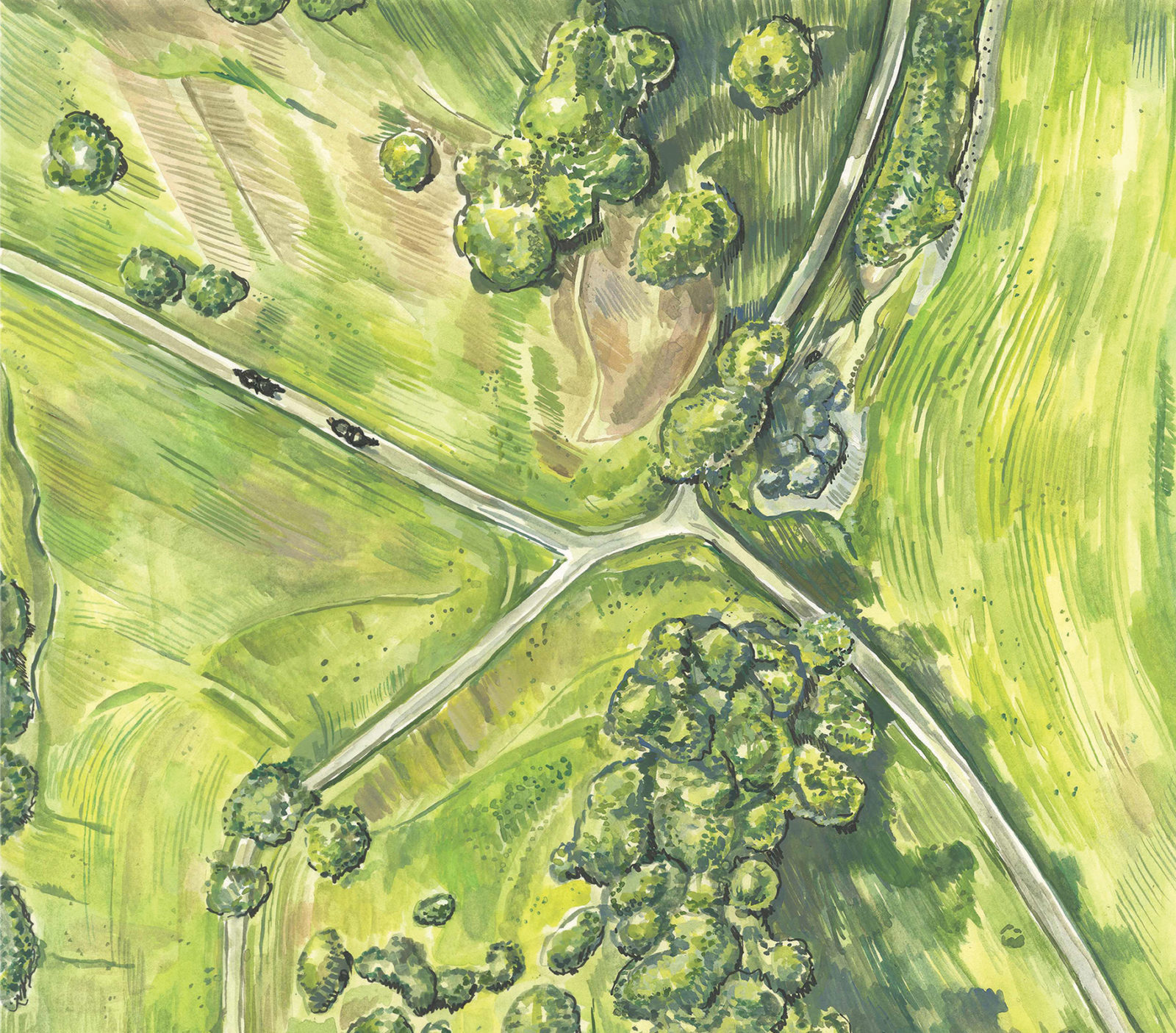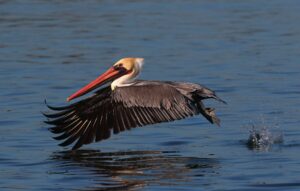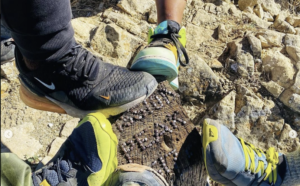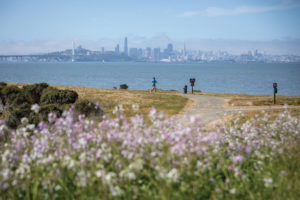We rounded a bend in the trail and Jinx’s ears flicked forward, attuned like satellite dishes. From the saddle, I felt his body tense as he eyed something coming up on the trail. He was excited, curious, a little scared. Honestly, a lot like me on most days. Our feelings are both rooted in evolution. His in being a horse, a prey animal, always ready to flee. Mine in being a human, always ready to analyze and process. Him, hyperconscious of the unpredictability of nature. Me, of the unpredictability of the modern world.
On that trail, Jinx had a chance to get out of the arena where we typically ride, cover new terrain, and, well, be a horse. For me, it was a chance to unplug and unwind. For these reasons and others, riders take to the trails in the East Bay Regional Park District, which have a combined 926 miles of routes accessible to horses. Though urban development radiating out from San Francisco has pushed barns into more rural areas, parts of the East Bay retain deep equestrian traditions. EBRPD trails are an important part of this heritage, including those that run through Diablo Foothills, where I rode Jinx that day.
I urged Jinx to continue and, soon, the object of his concern came into view: A boulder alongside the trail. Uninteresting to a human, but understandably concerning for a horse who might be frightened by a strangely-shaped, looming object, and wonder if a predator is hiding behind it.
Jinx is relatively small, just 16 hands high (about 5’3”, measured at the withers, the point where neck and back meet). Even though he was accompanied on the trail by Tanga, the biggest horse in the barn, Jinx led the way as the scout. He raised his head and blew his paisley-shaped nostrils at the boulder. Behind us, Tanga didn’t seem to notice it at all.
I put a hand on Jinx’s neck to reassure him.
“You’re okay, bud,” I said, nudging him forward. He relaxed. We walked on. Moments like that, communicating more-or-less seamlessly with an animal nearly 10 times my weight, remind me why I began riding as a child and why, nearly 25 years later, I’m still at it.
Horses have a complex history in California. They were brought here by the Spanish colonistsstarting in 1769. They quickly became synonymous with the missions and ranchos that popped up, says Amelia Marshall, a longtime horseback rider and co-author of Oakland’s Equestrian Heritage. Spanish law prohibited Native Americans from riding, but in California, over the objections of military officials, missionaries deliberately taught Native Americans to ride. Horses (and the unpaid Mexican and Native vaqueros who rode them) became essential to rancho families in the Bay Area, such as the Moragas (for whom the town is named), who dealt in hides and tallows.
Remember, they are an exotic species in the Western United States, and are rapidly increasing their geographic range and range of habitats. Are they outcompeting or excluding native species in the process? How would we know? We have done almost nothing to monitor changes in the assemblage of mushroom species in areas before and and after the incursion of death caps.
Further Reading
Pringle et al, “The ectomycorrhizal fungus Amanita phalloides was introduced and is expanding its range on the west coast of North America,” Molecular Biology 2009
Lockhart et al, “Simultaneous emergence of multidrug-resistant Candida auris on 3 continents confirmed by whole-genome sequencing and epidemiological analyses,” Clinical Infectious Diseases 2017
Battalani et al, “Aflatoxin B1 contamination in maize in Europe increases due to climate change,” Scientific Reports 2016
Explore Trail Riding
While many horse owners set out on popular trails through Briones, Anthony Chabot, and other East Bay Regional parks, the number of trail riding operations for the general public have dwindled due to insurance issues and the high cost of maintaining horses. Though the majority of trail riding stables can be found south in Half Moon Bay or north in Marin County, several East Bay programs still take riders through the parks for an afternoon or even a whole day:
»Trail Rides: Classic, guided trail excursions with no equestrian experience necessary.
•Nola Giddings Peruvian Paso: Peruvian Paso horses are known for their magnificent gaited walk, which looks like a highstep and is incredibly smooth to ride. Trainer Nola Giddings and her team offer trail rides on this breed, and others, through various East Bay parks. ngpph.com
•Chaparral Ranch: Located in Milpitas, Chaparral Ranch offers trail rides throughout Northern California. Those who want a taste of East Bay trails can pick up a trail ride starting at Ed Levin Park, which goes north through EBRPD’s Mission Peak. chaparralcorporation.com
»Trail Lessons: These programs offer supervised trail rides for those who have already learned the basics in the arena.
•Las Trampas Stables: Located on the cusp of the Las Trampas Regional Wilderness, this stable offers lessons on the trail for their students. (925) 855-1570; crhorses247@gmail.com
•Castle Rock Arabians: Since 1971, this program has specialized in working with Arabians, spirited horses with distinctive dish-shaped heads. Trail lessons run through Diablo Foothills Regional Park. castlerockarabians.com
For more information on equestrian resources in the EBRPD visit ebparks.org/ activities/equestrian/default.htm
Horses were one of the most widely used forms of transportation until automobiles arrived in the 1920s. Even after the advent of mechanized vehicles, Oakland’s cowboys kept on, persisting through the 1970s. Mills College had a renowned equestrian program; ranches ran along Mountain Boulevard from Montclair Village to Knowland Park; and a woman named Beatrice Graham operated stables on Telegraph Avenue in Oakland, at the site of the John Muir Elementary School in Berkeley, and on the corner of Skyline and Redwood Road in the Oakland Hills.
Yet urbanization gradually pushed out equestrians. After the completion of the Caldecott Tunnel in 1937, the open ranchlands of Orinda and Contra Costa County began to transform into suburbs. The paving of the 580 freeway and of Highway 13 in the 1950s and 1960s required the demolishment of many of Oakland’s barns and ranches.
But riders continued to venture into the hills, the edges of Alameda and Contra Costa counties, and the EBRPD trails.
“It’s really cool that someone can still have this experience in a busy metropolitan area,” says Bridget Calvey, EBRPD park supervisor for Diablo Foothills. “It’s completely unique. There are many East Bay stables around here that were established 40 years ago, or later. It’s part of the culture of the area.”
Equestrians pose unique maintenance considerations for the park district. During the rainy season hooves can create potholes in trails. Manure disposal from stables and horse boarding facilities must be carefully managed on park land as it can disrupt the local ecosystem and pollute waterways. And when creating new trails, the EBRPD has to consider when paths may be too narrow for a horse and hiker to safely pass each other, either widening them or limiting access. Matt Graul, EBRPD chief of stewardship, says that horses don’t usually create ecological sustainability issues and that most riders observe the rules and regulations. (The National Park Service has found that horse manure can carry the seeds of invasive plants, meaning that horses defecating on trails could contribute to the spread of nonnative plant species. In Point Reyes National Seashore, the National Park Service asks riders to give their animals weed-free feed for a few days before visiting the park.)
I started riding in these parks. As a little girl in Oakland in the 1990s, my family often spent Sundays in Tilden Park. My dad took me to the miniature steam train or the antique carousel. But if I had my pick, we’d go to the pony rides. Even as a kid, I knew that these ponies were old and docile and totally uninterested in my antics, but I leaned down and petted their necks and encouraged them to walk faster, marveling at it all. I associated horses with freedom. I lived in a remote part of the hills without a sidewalk or kids to play with. I imagined that, with a pony of my own, I could go anywhere I wanted.
When I was 6, I attended the Culpepper Horse Camp, a Western-style summer program run out of Anthony Chabot Regional Park. My favorite mount was a black mare named Brave. On our final day of camp, we showed our parents what we’d learned. We walked around the arena unaided, navigated our way around a line of cones, and maybe trotted if we were lucky. My mom took pictures of me riding Brave; I trimmed one of the photos with scissors and placed it in a heart-shaped locket, which I still keep in a box of childhood trinkets.
From then on, I asked for money for birthdays and Christmas, did chores around the house, and saved every bit of allowance to pay for trail rides at Chabot. Often my parents would drop me off and I’d set out on the trail with random families and city slickers. I was in the Oakland Hills, mere minutes from where I lived, yet it felt like a world away.
Any parent of a horse-crazy girl knows that things can escalate quickly and, oh, did they ever. My riding moved from parks into arenas. I began English riding lessons and learned how to jump. I moved on from ponies to ex-racehorses. Then, at 16, I got a 4-year-old chestnut gelding named Jinx. He was pumpkin orange in the winter and copper like a penny in the summer. I was smitten.
Thirteen years later, we’re still a team. We have gone on trails together, but most of our effort is spent on show jumping. I hadn’t ridden the East Bay Regional Parks trails where I first learned how to ride for decades. Until now.
During this interval, the local equestrian community has struggled. The Tilden pony rides have shut down, as have Chabot’s trail operations and several area barns. Property is more expensive than ever, increasing the costs of maintaining an already expensive animal. Barn owners near developed areas must carefully manage flies, dust, and manure to avoid bothering neighbors. Expenses also include pricey insurance and the increasingly costly gasoline and diesel fuel required to haul hay and run farm equipment. Many programs near city centers cater to English riders, who typically need less space than Western riders, and many Western riders have moved their mounts to areas with more space and cheaper boarding.
Considering the number of barns that have closed and fought to stay open, it’s remarkable that that EBRPD has kept so many trails open to riders.
“The East Bay Regional parks is arguably the finest parks system in the world,” says Marshall, who has volunteered with EBRPD for 19 years, and who rode with the district’s Volunteer Mounted Patrol for seven of those years. “The fact that equestrian use has been longstanding in the park district since its inception means that equestrians’ needs are kept in mind when the district formulates its land-use plans.”

We trailered Jinx and Tanga to Diablo Foothills, which is less than a 10-minute trailer ride from where they’re boarded in Walnut Creek. Nestled between Mount Diablo State Park and the Shell Ridge Open Space, Diablo Foothills Regional Park has 1,060 acres with grasslands, sandstone formations, established oak trees, and views of the East Bay. All of its trails are open to horseback riders.
The Diablo foothills were quiet when we arrived at the trailhead late Saturday morning. We trotted up hills and passed a big field with patches of low-slung spider webs on the ground.
Trail riding isn’t for everyone. It’s dominated by Western riders. Many English-style riders—those who do dressage, jumpers, and so on—have high-strung mounts and prefer the relative safety of the arena. Alarming stories about accidents on the trail abound. Broken bones, bad falls, even encounters with mountain lions. But many of the gravest dangers come from other humans—mountain bikers who zip around turns too fast or dog walkers who allow their pets off leash. “Many city dogs have never seen a horse before,” Marshall said. “Owners believe that their pet is very well trained and will come when called. I have seen the shock on the owners’ faces when their dog ignores the command to ‘come’ when it first encounters a horse on the trail.” In 2008, four dogs in Redwood Regional Park charged 74-year-old Ed Rorke, who was aboard his 24-year-old gelding. The horse spooked, bolted, and tumbled off the narrow trail, falling down a steep slope. Though Rorke got caught in underbrush, which slowed his descent, his horse fell hundreds of feet further, and died.
The trails Jinx and I traveled on in the past were, for the most part, privately owned and for horses only. The safety of our own barn was just a short jaunt away. Jinx was familiar with the route; if I fell off and Jinx bolted, he would likely run back to his stall. But not this trail. As I secured Jinx’s saddle alongside the trailer that morning, his antsiness made me nervous. He ignored the hay we’d brought for him, instead pawing the ground and tossing his head. But once we set out, he became focused. After the dreaded boulder, we passed dog walkers, bikers, and speedy ground squirrels. Nothing fazed him. Then we looped back through Buckeye Ravine and found ourselves traveling down a razor-narrow path. A steep gorge opened before us that was full of rocks. We would have to navigate carefully.
“Is it a slider?” Suzanne, Tanga’s owner, asked jokingly, referring to a trail that’s so vertical that your horse has to sit back on its haunches and basically sled down.
I told her that we could make it. I hoped so, anyway. So down we went. At first, Jinx seemed nervous. He glanced back at Tanga as if he wanted to turn back. Impossible, I thought, considering the narrow path.
I urged him forward and leaned back in my saddle to help him balance as we proceeded downhill. He seemed to know what to do. He lifted his feet, gingerly navigating around protruding rocks, recognizing when to travel laterally for a better grip.
When we got to the bottom, he and Tanga were both sweating from the effort, but content. Trees flashing autumnal yellows and oranges flanked us. The air was cool. We sawmassive rock formations ahead and a flock of birds careening through the sky. We passed the peregrine falcon nesting area. Jinx easily traversed sections of smooth stone on the trail, even with his slippery metal horse shoes. I had underestimated him.
Back at the barn that afternoon, Suzanne and I bathed our horses and plotted our return to the trail. We had vacations, obligations, and scheduling conflicts, but we were determined to make it happen. I got in my car, turned on the AC, and headed home to Oakland on the 24, the freeway that had paved over so much of the farmland in Contra Costa County. Halfway home, traffic piled up. A grisly accident had shut down the freeway. As I sat in bumper-to-bumper traffic, I reminisced about when I was a little girl and believed a pony could transport me anywhere. I imagined getting out of my car, hopping aboard my horse, and riding off into the golden hills, leaving the glittering cars and hot asphalt behind.





